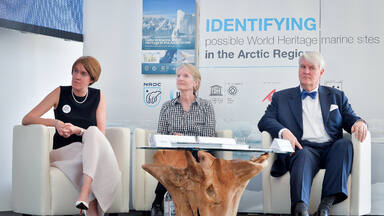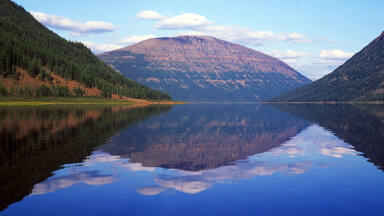Putorana Plateau
Putorana Plateau
This site coincides with the area of the Putoransky State Nature Reserve, and is located in the central part of the Putorana Plateau in northern Central Siberia. It is situated about 100 km north of the Arctic Circle. The part of the plateau inscribed on the World Heritage List harbours a complete set of subarctic and arctic ecosystems in an isolated mountain range, including pristine taiga, forest tundra, tundra and arctic desert systems, as well as untouched cold-water lake and river systems. A major reindeer migration route crosses the property, which represents an exceptional, large-scale and increasingly rare natural phenomenon.
Description is available under license CC-BY-SA IGO 3.0
Plateau de Putorana
Ce site, qui coïncide avec la Réserve naturelle d'Etat de Putorana, se trouve dans la partie septentrionale de la Sibérie centrale, à une centaine de kilomètres au nord du cercle polaire. La partie du Plateau inscrite sur la Liste du patrimoine mondial abrite un ensemble complet d'écosystèmes arctiques et subarctiques dans une chaîne de montagnes isolée : des systèmes de taïga, de toundra, de désert et des systèmes lacustres et fluviaux d'eau froide intacts. Il est un lieu de migration de rennes sauvages, ce qui est un phénomène naturel exceptionnel, de grande ampleur et de plus en plus rare.
Description is available under license CC-BY-SA IGO 3.0
الموقع الروسي هو
هضبة بوتورانا (الاتحاد الروسي) إن هذا الموقع، الكائن في الذُخْر الطبيعي في ولاية بوتورانا، يوجد في الجزء الشمالي من سيبيريا الوسطى، على بُعد نحو مائة كيلومتراً شمال الدائرة القطبية. ويضم الموقع مجموعة كاملة من النظم الإيكولوجية القطبية وشبه القطبية في سلسلة من الجبال المعزولة، مثل: نُظُم التايغا والتُندرا والصحراء، إضافة إلى النُظُم البحيرية والنهرية السليمة ذات المياه الباردة. ويمثل الموقع ملجأً لهجرة الرنّة البرية، وهو ما يُعتبر ظاهرة طبيعية استثنائية ضخمة تتزايد ندرتها.
source: UNESCO/CPE
Description is available under license CC-BY-SA IGO 3.0
Плато Путорана
Этот объект совпадает своими границами с Путоранским государственным природным заповедником, расположенным в северной части Центральной Сибири, в 100 км за Полярным кругом. На части этого плато, включенной в Список всемирного наследия, сохранился полный набор субарктических и арктических экосистем, сохранившихся в условиях изолированной горной цепи, в том числе - нетронутая тайга, лесотундра, тундра и системы арктических пустынь, а также первозданное озеро с холодной водой и речные системы. Через объект пролегает основной путь миграции оленей, что являет собой исключительное, величественное и все более редко встречающееся явление природы.
source: UNESCO/CPE
Description is available under license CC-BY-SA IGO 3.0
Meseta de Putorana
Situado en la parte septentrional de la Siberia Central, a unos 100 km al norte del círculo polar ártico, la parte de la meseta inscrita en la Lista abarca la totalidad de la Reserva Natural Estatal de Putorana. La reserva comprende una cadena montañosa aislada con un conjunto completo de ecosistemas árticos y subárticos intactos de taiga, tundra y desierto, así como de lagos y ríos. Este sitio es un lugar de migración masiva de renos salvajes, un fenómeno natural extraordinario cada vez más raro.
source: UNESCO/CPE
Description is available under license CC-BY-SA IGO 3.0
プトラナ高原
source: NFUAJ
Putorana plateau
Source: unesco.nl
Outstanding Universal Value
Brief synthesis
Comprising a vast area of 1,887,251 ha, the property is located in the centre of the Putorana Plateau in the northern part of Central Siberia. The part of the plateau inscribed on the World Heritage list harbours a complete set of subarctic and arctic ecosystems in an isolated mountain range, including pristine taiga, forest tundra, tundra and arctic desert systems, as well as untouched cold-water lake and river systems. The combination of remoteness, naturalness and strict protection ensure that ecological and biological processes continue at a large scale with minimal human influence. The property provides a dramatic demonstration of ecological processes, including the interactions between healthy populations of a full range of Arctic fauna. A major reindeer migration crosses part of the property. The property is also one of the very few centres of plant species richness in the Arctic.
Criterion (vii): A vast and diverse landscape of striking natural beauty, the Putorana Plateau is pristine and not affected by human infrastructure. Its superlative natural features include an extensive area of layered basalt traps that has been dissected by dozens of deep canyons; countless cold water rivers and creeks with thousands of waterfalls; more than 25,000 lakes characterized by a fjord-like formation that is associated with a large variation in the relief. The immense arctic and boreal landscapes remain intact with carpets of lichens and forest that are unusual at such northern latitudes.
Criterion (ix): The property displays a comprehensive set of ecological and biological processes associated with its diverse arctic and subarctic ecosystems. Its bio-geographical location, on the border of the tundra and taiga biomes and at the transition between Western and Eastern Siberian floras, makes the property one of only a few centres of plant species richness in the Arctic. The combination of landscape diversity, remoteness, naturalness and degree of protection are extraordinary. In addition, the property may provide valuable evidence on the impacts of climate change to large-scale natural arctic ecosystems if proper monitoring and research take place.
Integrity
The property is a strictly protected State Nature Reserve, or “Zapovednik”: its boundaries coincide with those of the Putoransky State Nature Reserve, established in 1987. The property is large and is surrounded by an extensive buffer zone of 1,773,300 ha. The property's size, remoteness and naturalness, as well as the degree of protection afforded to it are essential attributes in ensuring the protection of the full range of largely undisturbed landscapes and processes that are the basis of its Outstanding Universal Value. The property includes the key areas and features that are essential for maintaining the property’s natural beauty. A full range of important natural features, such as lakes, canyons and waterfalls, is located within its boundaries. The property is also of sufficient size and contains the necessary elements to maintain the ecological and biological processes that are essential for the long term conservation of the property’s ecosystems and biological diversity, and the migratory species that rely on its natural state.
Difficult access is also a contributor to the property’s integrity: there are no roads within the property and large parts of the buffer zone, thus the property is only accessible by helicopter or boat. The property is also unaffected by the impacts of mining and other land-uses incompatible with its values. Important natural values linked to the property are located in the buffer zone, and their conservation is also an essential requirement.
Protection and management requirements
The property was declared a strictly protected State Nature Reserve (Zapovednik) in 1987. No land or resource uses are allowed other than scientific research and monitoring. A number of other federal and regional laws and regulations on nature conservation, land use planning, scientific research and monitoring, and environmental education apply to the property.
The combination of a strict legal and management framework, remote location and lack of any road infrastructure enables effective management of the property with relatively modest staffing and funding levels for a protected area of this magnitude. Increasing tourism in the buffer zone carries the risk of unauthorized access to the property, including for hunting and fishing. There is a need for unambiguous and rigorously enforced land use and building arrangements in the buffer zone and for regulations of tourism, including strict limits on air traffic.
Mining is a potential threat to the property. The Federal Law on Specially Protected Natural Areas prohibits mining in the property. It must be ensured that the impacts of existing and future mining outside the property will not affect in any way the Outstanding Universal Value and/or integrity of the property, for example through air pollution, pipelines or the development of any supporting infrastructure.
One of the most important inter-regional reindeer migration routes crosses the property. As the continuation of this natural phenomenon depends strongly on the natural conditions of the areas within and outside the property, effective legal and management systems are required to ensure that human use, including tourism, mining and other development will not adversely affect this phenomenon.


